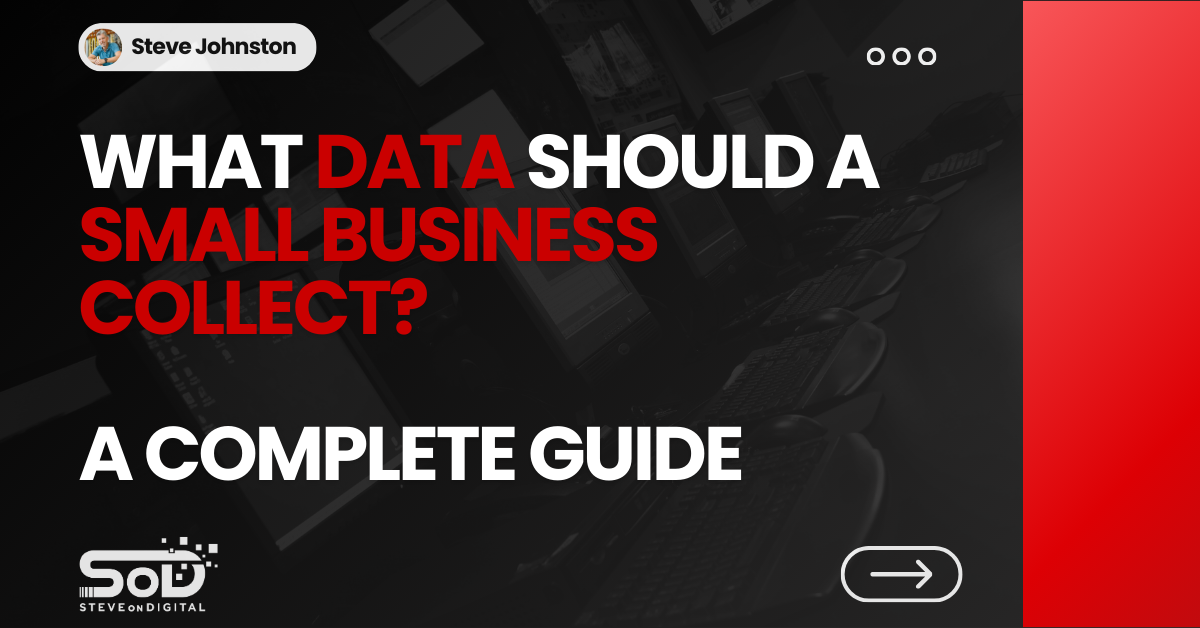In my role as a Digital Transformation Specialist, I’ve seen firsthand how crucial data is in understanding market trends and customer behaviors.
Data isn’t just numbers; it’s the cornerstone of smart business decisions.
By analyzing customer data, small businesses can uncover patterns that inform product development, marketing strategies, and even operational changes.
For example, by tracking which products customers spend the most time viewing on your website, you can prioritize stocking those items or promoting them more heavily.
But it’s not just about having access to data. It’s about having the right data.
In the digital era, where every interaction can be tracked and measured, small businesses can quickly become overwhelmed with the amount of information available.
That’s why it’s essential to focus on business decisions that are informed by relevant data points.
This approach ensures that you’re not just collecting data, but using it to make informed decisions that directly impact your business’s growth and efficiency.
Navigating Challenges In Data Collection
Collecting the right data can be a daunting task, especially for small businesses that may not have dedicated data teams.
The challenge often lies in knowing which data to collect and which tools to use.
For instance, small businesses need to avoid the pitfall of collecting all available data without discerning its relevance.
This can lead to costly mistakes, such as investing in marketing strategies that do not align with customer needs or business objectives.
Choosing the correct data type to collect is crucial.
For my own businesses, SteveOnDigital, StemJee and MindfulTech Institute, I focus on collecting qualitative and quantitative data that directly relates to our operational needs and customer engagement metrics.
This selective approach helps prevent the overload that comes from trying to analyze irrelevant data, allowing us to focus on information that genuinely contributes to strategic decision-making.
Data collection methods also need to be carefully considered to ensure accuracy and relevance.
Secondary data collection, for instance, can be a cost-effective way to gather insights without conducting primary research.
However, it’s important to validate the sources and relevance of this data to your specific business context to avoid basing decisions on outdated or incorrect information.
Comprehensive Guide To Essential Data Types
Customer Acquisition Data
Understanding how customers find your business is crucial for optimizing marketing efforts and increasing visibility.
In my experience, using online surveys and market research has proven effective in identifying the main channels through which potential customers discover our services.
Additionally, tools like Google Analytics offer invaluable insights into customer demographics and behavior, allowing businesses to tailor their marketing strategies more effectively.
For instance, by analyzing data collected through Google Analytics, we can see which marketing channels are driving the most traffic to our website and adjust our budget to focus more on those channels.
This targeted approach not only saves time but also enhances the effectiveness of our marketing efforts.
Customer Engagement Data
Once customers find your business, engaging them effectively is key to building lasting relationships.
Tracking interactions through your website or physical store can provide critical insights into customer preferences and behavior.
Social media analysis and customer feedback are also invaluable data sources for understanding how customers interact with your brand.
For example, we regularly analyze feedback collected from social media and other platforms to understand our customers’ communication preferences.
This information helps us tailor our outreach and engagement strategies, ensuring that we meet our customers’ expectations and enhance their overall experience with our brand.
Customer Retention Data
Retaining customers is often more cost-effective than acquiring new ones.
Understanding why customers leave—or why they stay—can provide essential insights for improving service and product offerings.
Direct feedback and studies on customer purchase history and lifetime value are particularly useful for this purpose.
Effective Data Collection Methods
Primary Data Collection Techniques
In my experience running SteveOnDigital, directly engaging with customers has always been a cornerstone of how we understand their needs and preferences.
Here are a few methods we’ve found particularly effective:
- Surveys: Simple yet powerful, surveys are a direct way to gather valuable insights about what our customers want and need. By asking the right survey questions, we collect data that informs everything from product development to marketing strategies.
- Focus Groups: These offer a more nuanced understanding by allowing real-time interaction with a small group of customers. The feedback from these sessions is often rich in detail and provides qualitative data that can be transformative for our business strategies.
- Digital Tools: Using tools like Google Analytics helps us gather real-time data about how users interact with our website. This data is crucial for understanding which parts of our site work well and which parts need improvement.
Secondary Data Collection Practices
While primary research is invaluable, secondary data collection also plays a critical role in our overall strategy.
Here’s how we approach it:
- Industry Reports: These reports provide a broader context for our market and consumer trends. By analyzing this secondary data, we can benchmark our performance and identify opportunities within our industry.
- Social Media Analysis: Platforms like Twitter and Facebook are gold mines for brand sentiment analysis. Monitoring mentions and customer feedback on social media helps us gauge public perception and adjust our strategies accordingly.
Optimizing The Mix Of Data Collection Methods
Finding the right balance between different data collection methods can significantly enhance the effectiveness of our strategies.
Here are some ways we achieve this balance:
- Balancing Research Types: By combining quantitative data from surveys with qualitative insights from focus groups, we get a holistic view of our market and customer base.
- Strategic Alignment: We tailor our data collection methods to align with specific business goals, ensuring that the information we collect is both relevant and actionable.
- Using Cost-Effective Tools: Small businesses like ours need to be mindful of budget constraints. Leveraging free and affordable tools for data collection, such as online surveys and open-source analytics platforms, helps us stay efficient and cost-effective.
Data Analysis For Strategic Insights
Analyzing And Reporting Data
Once data is collected, the next step is turning it into actionable insights:

- Deciphering Patterns: We analyze customer data to identify trends and patterns. This analysis helps us predict customer behavior and adapt our strategies to better meet their needs.
- Synthesizing Data: Using CRM systems and accounting software, we integrate various data points to get a comprehensive view of our customer journey and financial health. This integrated approach helps us make informed business decisions quickly and efficiently.
Data Security And Ethical Considerations
Data security and ethical data management are paramount for maintaining customer trust and complying with legal standards:
- Secure Data Storage: We use encrypted storage solutions and robust data management practices to ensure all customer data is kept secure. This protects both our customers and our business from potential security breaches.
- Compliance with Regulations: Adhering to regulations like GDPR is not just about compliance; it’s about respecting our customers’ privacy and rights. We take this responsibility seriously, ensuring that all data collection and storage practices are compliant and ethical.
- Building Trust: By managing data responsibly, we build trust with our customers. They know their information is safe with us, which enhances their overall customer experience and loyalty to our brand.
Leveraging Data To Propel Business Growth
Enhancing Customer Experience
In my years steering SteveOnDigital, I’ve learned that enhancing the customer experience is key to sustained business success.
Here’s how I use data to make that happen:
- Personalizing Marketing and Communications: Data from customer interactions helps us tailor our communications in ways that resonate deeply with our target audience. For instance, by analyzing purchase history and browsing behavior, we can send customized offers that are much more likely to convert.
- Identifying Improvement Areas: Customer feedback is a goldmine for improvement. Whether it’s through direct feedback, online surveys, or social media, each piece of feedback helps us understand where we can do better. This approach not only helps us meet customer needs but also strengthens their loyalty to our brand.
- Creating Targeted Loyalty Programs: With insights drawn from data analytics, we develop loyalty programs that genuinely reward our customers’ specific behaviors and preferences, encouraging repeat business and enhancing overall satisfaction.
| Feedback Theme | Common Customer Comments | Actions Taken |
| Product Quality | “Wish the product durability was better.” | Improved material quality in the next batch. |
| Website Usability | “Had difficulty navigating the checkout page.” | Redesigned user interface to simplify checkout. |
| Customer Service Response | “Support was slow to respond.” | Implemented a faster, tiered response system. |
Optimizing Marketing And Sales Efforts
Data not only helps in understanding customers but also in refining our marketing and sales strategies to be more effective:

- Allocating Budgets: By leveraging data from Google Analytics and sales reports, we strategically allocate our marketing budget to channels that offer the highest return on investment. This data-driven approach ensures we maximize the impact of every dollar spent.
- Refining Marketing Strategies: Data insights help us fine-tune our marketing campaigns for better reach and conversion rates. For example, A/B testing different ad formats and content styles lets us identify what works best for engaging potential customers and driving sales.
| Marketing Channel | Customer Reach (Monthly Views) | Conversion Rate (%) | Budget Allocation (%) |
| Social Media | 45,000 | 3.2 | 25 |
| Email Marketing | 30,000 | 5.1 | 30 |
| PPC (Pay-Per-Click) | 20,000 | 2.5 | 20 |
| SEO (Organic Search) | 50,000 | 4.0 | 25 |
Strategic Business Decision-Making
Data is at the heart of all our strategic decisions, from product development to market expansion:
- Developing Products And Services: Customer data insights guide our product development process, ensuring that new offerings are well-aligned with market demands and customer preferences.
- Managing Inventory And Resources: Effective data analysis helps us manage our inventory more efficiently, reducing overhead costs and minimizing waste. For instance, sales trend data informs our stock levels, ensuring we meet demand without overstocking.
- Exploring New Markets: By analyzing market trends and consumer data, we identify opportunities for expansion into new markets or segments, giving us a competitive edge.
| Decision Type | Data Utilized | Outcome |
| Product Line Expansion | Customer purchase history & preferences | Launched a new line of eco-friendly products. |
| Inventory Management | Sales trend analysis | Reduced excess stock by 15%, minimizing waste. |
| Market Entry | Consumer demographic and interest data | Entered the Asian market, growing sales by 20%. |
Conclusion
Adopting a data-driven culture has been crucial for the growth and resilience of SteveOnDigital:
- Recognizing Data as a Strategic Asset: We see data as an essential asset for our business longevity. It informs all our major decisions, from day-to-day operations to long-term strategic planning.
- Committing to Ongoing Data Collection and Analysis: Continuous improvement is part of our ethos. Regularly collecting and analyzing data ensures that our strategies remain relevant and effective, adapting to changing market conditions and customer needs.
- Strategies for Instilling a Data-Centric Mindset: We encourage all team members to think data-first. Training programs and regular discussions on data insights and trends help cultivate a mindset that values and uses data across all aspects of our operations.
In conclusion, integrating a robust data-driven approach into every layer of your business can transform challenges into opportunities for growth.
At SteveOnDigital, we’ve embraced this journey, seeing substantial benefits in customer satisfaction, operational efficiency, and strategic agility.
For other small businesses looking to thrive in a competitive market, starting with a solid foundation in data collection and analysis is not just advisable—it’s essential.





